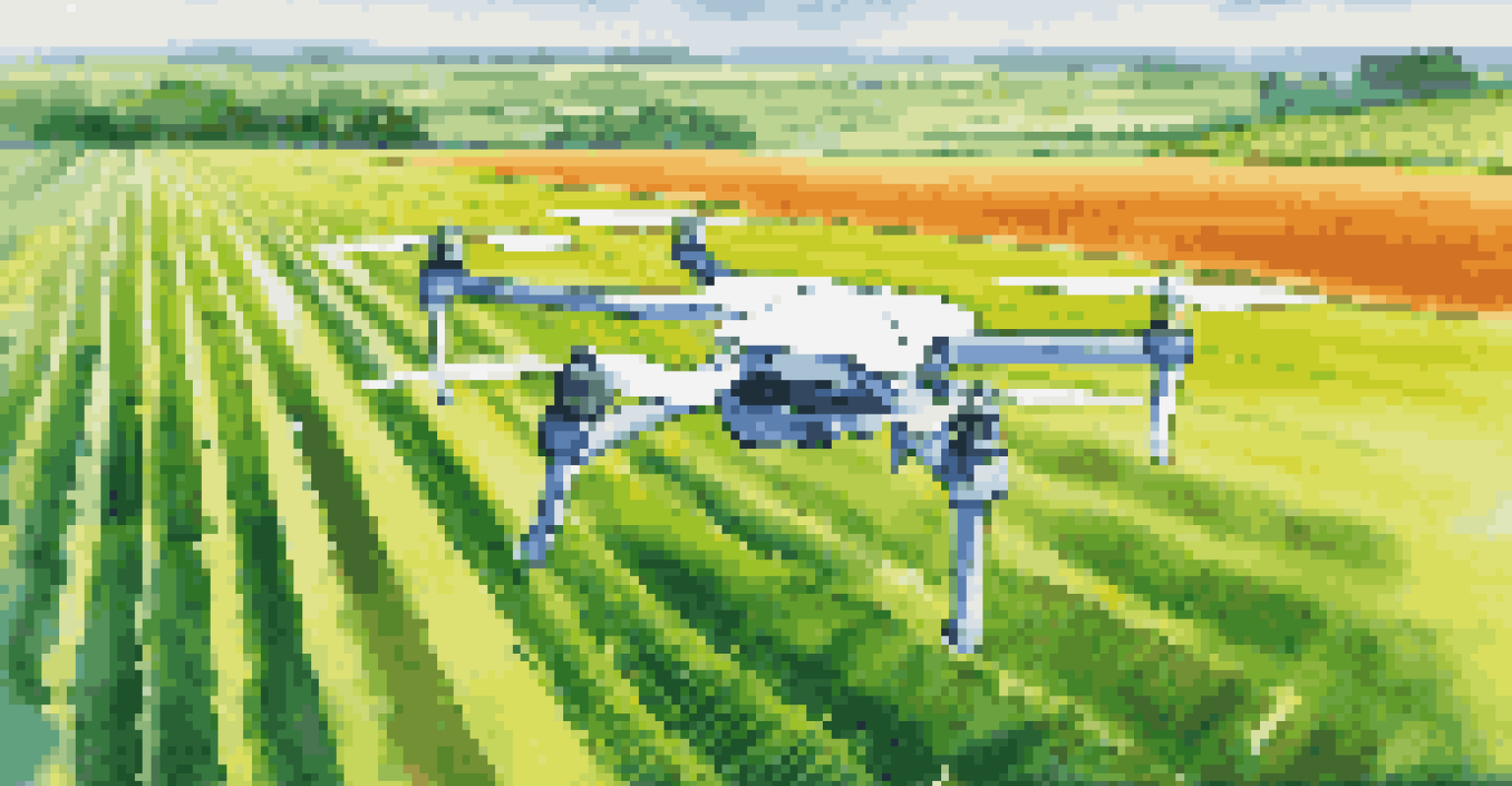The Impact of Climate Change on Technological Advancements

Climate Change: A Catalyst for Technological Innovation
Climate change has become more than just an environmental issue; it’s a driving force behind technological innovation. As the planet faces rising temperatures and extreme weather events, the need for sustainable solutions has never been clearer. This urgency pushes researchers and developers to create new technologies that can mitigate the effects of climate change.
The greatest threat to our planet is the belief that someone else will save it.
For example, advancements in renewable energy technologies, such as solar and wind power, are largely a response to the need for cleaner energy sources. These innovations not only help combat climate change but also create new industries and job opportunities. Thus, climate change acts as both a challenge and a motivator for technological progress.
Moreover, this shift is not limited to energy; it spans various sectors, including agriculture, transportation, and construction. As companies and governments adapt to changing conditions, the demand for innovative solutions continues to grow, fostering an environment ripe for technological breakthroughs.
Renewable Energy: Innovations Shaping the Future
One of the most significant areas where technology is evolving due to climate change is in renewable energy. Solar panels and wind turbines are becoming more efficient, largely thanks to research aimed at maximizing energy capture. For instance, new materials are being developed to enhance solar panel efficiency, allowing more energy to be generated from the same amount of sunlight.

Additionally, energy storage technologies, such as advanced batteries, are crucial for managing the intermittent nature of renewable energy. These innovations are essential for making renewable sources more reliable and accessible. As these technologies improve, they not only reduce our reliance on fossil fuels but also help stabilize energy costs.
Climate Change Drives Tech Innovation
The urgency of climate change is prompting significant advancements in technology across various sectors, from renewable energy to smart solutions.
The shift towards renewable energy is not just beneficial for the planet; it also drives economic growth. Investments in green technology are creating jobs and fostering new industries, proving that addressing climate change can yield substantial economic benefits.
Smart Technology: Adapting to Environmental Changes
Smart technology is another area where climate change has prompted innovation. With the rise of the Internet of Things (IoT), devices can now collect and analyze data to help us understand and respond to environmental changes more effectively. For example, smart irrigation systems can optimize water usage in agriculture, reducing waste and improving crop yields.
We do not inherit the earth from our ancestors, we borrow it from our children.
These technologies also extend to urban planning, where smart city initiatives aim to create more resilient infrastructures. By using data to anticipate and manage challenges like flooding or heatwaves, cities can better adapt to climate change impacts. This proactive approach helps ensure that communities remain livable even as conditions evolve.
Moreover, smart technology encourages energy efficiency in homes and businesses, contributing to reduced carbon footprints. As more people embrace these innovations, the collective impact on sustainability can be profound, showcasing how technology can align with environmental stewardship.
Agricultural Innovations: Feeding a Changing World
As climate change threatens food security, agricultural innovations are becoming increasingly important. Farmers are turning to technology to adapt to changing climates, whether through precision agriculture or genetically modified crops. These advancements allow for more efficient resource use, which is crucial in a world facing unpredictable weather patterns.
For instance, drones equipped with sensors can monitor crop health, enabling farmers to apply water and nutrients more precisely. This not only enhances yields but also minimizes waste, contributing to more sustainable farming practices. Such innovations are essential in ensuring that we can feed a growing global population while minimizing environmental impact.
Renewable Energy Fuels Economic Growth
Investments in renewable energy technologies are not only combating climate change but also creating jobs and fostering new industries.
Furthermore, vertical farming and hydroponics are gaining traction as methods that use less land and water. These approaches demonstrate how technology can help us rethink traditional agricultural practices, making food production more resilient against the challenges posed by climate change.
Transportation Innovations: Driving Towards Sustainability
Transportation is another sector witnessing significant technological advancements due to climate change. The push for electric vehicles (EVs) is a prime example, as consumers and manufacturers alike recognize the need for cleaner alternatives to traditional gas-powered cars. EV technology has rapidly evolved, with improvements in battery life, charging infrastructure, and overall performance.
Additionally, public transportation systems are being redesigned to be more efficient and eco-friendly. Innovations such as electric buses and energy-efficient trains are becoming popular, helping to reduce urban emissions. By investing in sustainable transportation solutions, cities are not only addressing climate change but also improving air quality and public health.
Moreover, the rise of shared mobility services, like ride-sharing and bike-sharing, is encouraging people to use fewer personal vehicles. These options help reduce traffic congestion and lower overall carbon emissions, illustrating how technology is reshaping our approach to transportation in response to environmental challenges.
Circular Economy: Technology Redefining Waste Management
The concept of a circular economy is gaining traction as a response to climate change, and technology plays a pivotal role in this shift. Unlike the traditional linear economy, which follows a 'take, make, dispose' model, the circular economy aims to minimize waste by reusing materials and resources. Technologies that facilitate recycling and upcycling are becoming essential in this new paradigm.
For example, advancements in waste sorting technology have improved the efficiency of recycling processes. Automated systems can quickly separate materials, making it easier to recycle plastics, metals, and paper. This not only reduces landfill waste but also conserves resources by reintroducing materials back into the production cycle.
Policies Propel Sustainable Solutions
Government regulations and incentives are crucial in driving the development and adoption of innovative technologies to address climate challenges.
Additionally, digital platforms are helping businesses and consumers connect to share resources and reduce waste. By leveraging technology, individuals can participate in the circular economy, promoting sustainability and contributing to a healthier planet. This innovative approach highlights how addressing climate change can lead to transformative changes in how we produce and consume.
Policy and Regulation: Driving Technological Change
Policies and regulations play a crucial role in shaping the landscape of technological advancements related to climate change. Governments around the world are increasingly implementing regulations aimed at reducing carbon emissions and promoting sustainable practices. These policies not only encourage innovation but also create a framework for companies to develop and adopt new technologies.
For instance, subsidies for renewable energy projects and tax incentives for electric vehicle purchases are examples of how policy can drive technological change. By providing financial support, governments make it easier for businesses and consumers to transition to greener options. This collaborative effort between the public and private sectors is essential for addressing the climate crisis effectively.

Furthermore, international agreements, like the Paris Agreement, set targets that compel nations to invest in clean technologies. As countries strive to meet their commitments, the demand for innovative solutions will continue to grow, ensuring that technology remains at the forefront of climate change mitigation efforts.
Conclusion: Embracing Change for a Sustainable Future
In conclusion, the impact of climate change on technological advancements is profound and multifaceted. As we face the realities of a warming planet, innovation becomes a key driver in our response. From renewable energy to smart technology and sustainable agriculture, the solutions emerging today are crucial for building a resilient future.
While the challenges are significant, they also present opportunities for growth and transformation. By embracing these innovations, we can not only address the impacts of climate change but also create a more sustainable economy. This journey requires collaboration between individuals, businesses, and governments to ensure that technology serves as a force for good.
Ultimately, the intersection of climate change and technology offers a unique chance to rethink how we interact with our world. By prioritizing sustainability and investing in innovative solutions, we can pave the way for a healthier planet and a brighter future for generations to come.